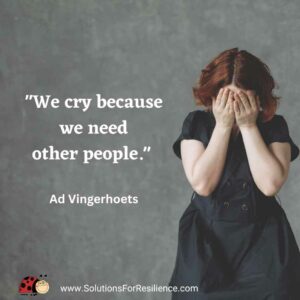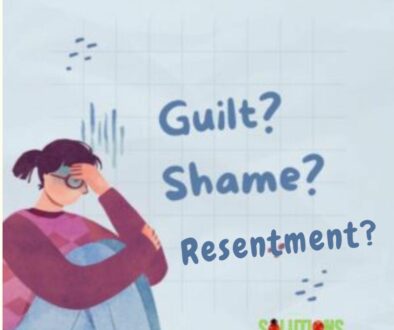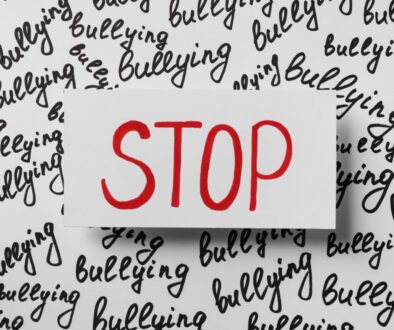Stop Crying or Let Your Tears Freely Flow?
To Stop Crying or Not?
It was during a therapeutic counselling session that my client’s eyes welled up with tears. She sobbed, “Why do I cry so easily? I want to stop crying!” I seldom meet a client who is comfortable with weeping. However, I do attempt to create emotional safety for tears to flow by saying something like, “I welcome your tears. It is an honor to see them.”
Previously to her release of tears, we had identified that she often experiences a lump in her throat. She described it as like a small bouncy ball. It was her unconscious attempt to swallow her painful hurt. That blocking lump was a helpful coping strategy in her childhood. It helped protect her from parental shaming. But this dam, which held back her sadness and tears, was weakening.
Rationally, she knew that all babies cry and that as humans, we cry to express our sorrow or how deeply touched we are. Yet, for my client, the shame lingered.
The Science of Crying
Research on the topic of crying helps us challenge childhood and workplace shaming.
One: In Crying: The Mystery of Tears, the biochemist William Frey concluded that nearly one-half of the time we cry, we are expressing sadness
Two: From the Harvard Medical School we learn:
There are different kinds of tears:
- Reflex tears and continuous tears cleanse our eyes from dust, smoke and other particles that could create infection. They consist of ninety-eight percent water.
- Emotional tears flush out distress hormones and other toxins.
Indeed, often when we have a good cry we release oxytocin, the relationship hormone.
Crying can indicate that we have an unresolved problem when we cry frequently, for no apparent reason, or when it is uncontrollable or interferes with our daily living. Likewise, the inability to cry, when you want to, can be a problem. Under any of these circumstances, therapy will probably help.
Conversely, sometimes allowing yourself to cry can help heal loss and grief. Males’ health might improve if they had the emotional freedom and safe places to cry.
Three: A University of South Florida study found that crying provided less release when the individual experienced shame around doing so. They also found that lack of emotional insight hindered experiencing the positivity of crying. Researcher and professor of psychology, Jonathan Rottenberg said, “Crying signals to yourself and other people that there’s some important problem that is at least temporarily beyond your ability to cope.
Four: Cry researcher and Professor of Clinical Psychology at Tilburg University in the Netherlands, Dr. Ad Vingerhoets authored the book, Why Only Humans Weep. He is convinced that tears provide a visible signal that trigger others’ empathy. Crying then becomes part of our need for connection. Vingerhoets states,
“We cry because we need other people.”
Quotes about Crying
Researchers, as well as ancient and recent philosophers, honor the act of crying. Never do they suggest you must cry nor stop crying.
- “Keep me away from the wisdom which does not cry, the philosophy which does not laugh and the greatness which does not bow before children.” Kahil Gibran, Lebanese American poet and philosopher
- “It is better to cry than drown on the inside.” Gwendolyn Jansma, Psychologist and Shaman
- “Joy’s smile is much closer to tears than laughter.” Victor Hugo, French poet and playwright
- “I have started to believe that cryingwith strangers in person could save the world.” Brené Brown, shame, and vulnerability researcher
- “I cry every chance I get.” Richard Gere, American actor
Will I Cry, Not Cry or Stop Crying?
Here are some ideas that may support you the next time the issue of crying surfaces.
If you have the urge to cry and tears are welling up, stuffing them is not a good idea. If shame is blocking the process, exploring your childhood messages may help.
- It is unhelpful to believe something is wrong with you if you do or do not cry.
- Having compassion for yourself, just as you would for a crying baby, can give tears their rightful acknowledgement.
- It is important to find safe places and people who provide emotional safety to cry, or at minimum to freely share how you feel.
- If crying is disrupting your functioning, it is an indication that your nervous system needs calming. While not denying how you feel, use some grounding techniques. You might use breathing strategies, go for a walk, sing, hum, or ask for a hug.
- Consider freeing up a day to compassionately feel. Wrap yourself up in a cozy blanket with a soothing beverage and a good book or journal. Let yourself feel. Welcome tears, while neither forcing them or denying them.
- There may be several reasons for crying more, and to the point of not functioning. First, you may have some significant grieving to do. Second, past, and unresolved trauma may be surfacing. Third, if you burst into tears when feeling frustrated or angry, you probably have unresolved trauma or significant distress at work or home. Consider seeking professional support for all these situations.
Conclusion
I recall in the early 1960s singing along with Lesley Gore as she lamented:
“It’s my party, and I’ll cry if I want to
Cry if I want to,
Cry if I want to,
You would cry too, if it happened to you.”
I didn’t know then what good role modeling that was. Please consider if you have tears streaming down your face not telling yourself to stop crying. Crying just might lead to feeling relief, especially if you are being seen, acknowledged, and comforted by a caring witness.





